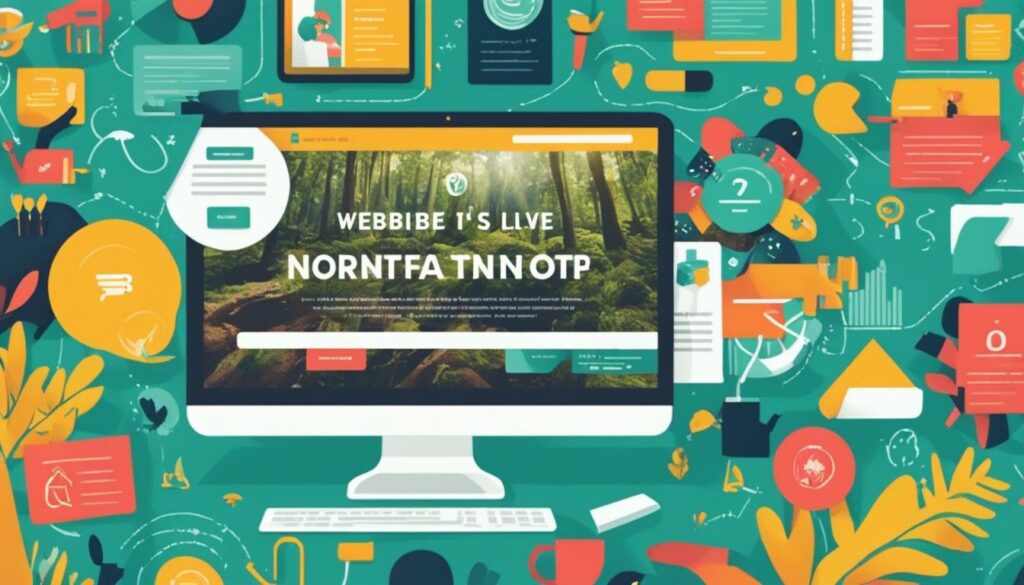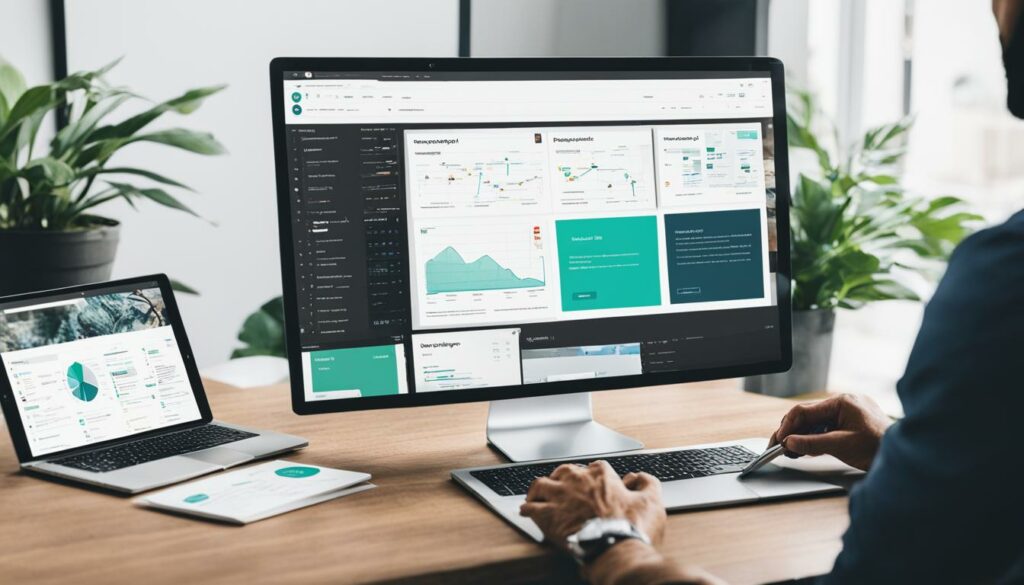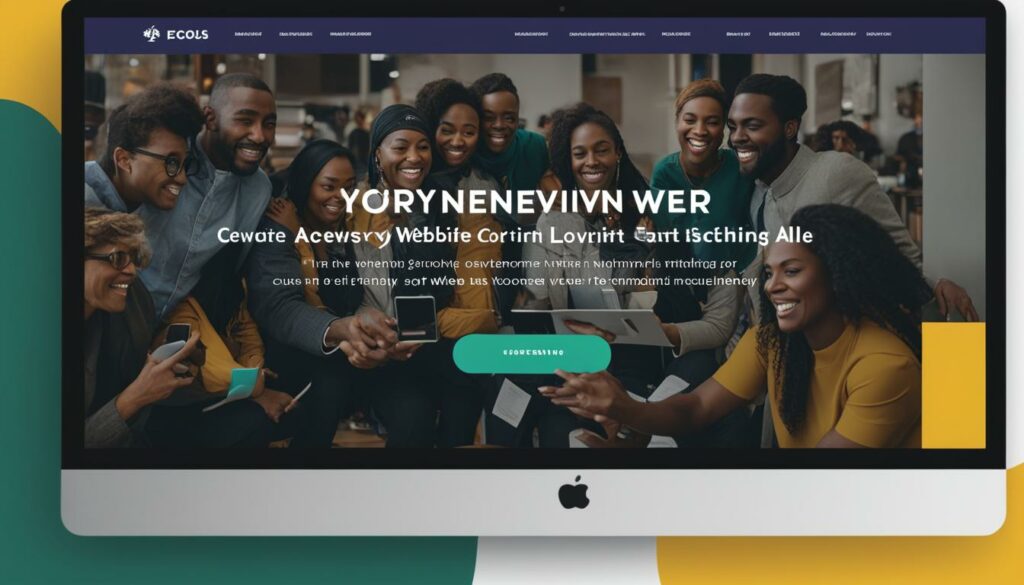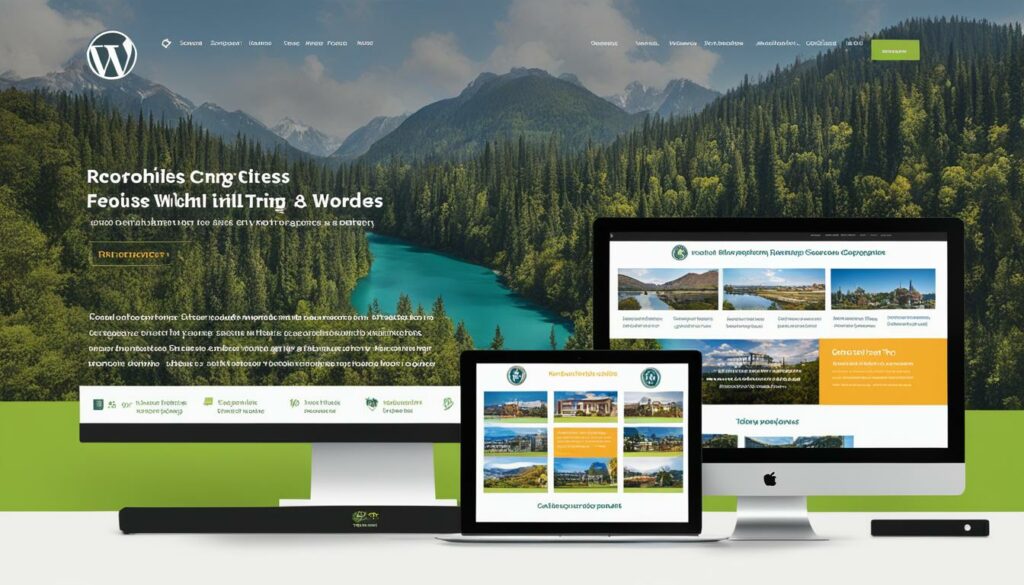Welcome to the world of mission-driven web design! In today’s digital age, a strong online presence is crucial for nonprofits to effectively communicate their mission and connect with supporters. And that’s where WordPress comes in. As a powerful and user-friendly website builder, WordPress empowers nonprofits to create professional and impactful websites without breaking the bank.
With WordPress, you don’t need to be a tech guru to build a stunning website. Its flexible design options and extensive library of themes and plugins allow you to customize your site to reflect your organization’s unique brand and values. Whether you’re looking to showcase your programs, share success stories, or collect donations, WordPress has got you covered.
If you’re ready to take your nonprofit’s online presence to the next level, we recommend WordPress Hosting from BoostedHost. Their optimized hosting solution ensures optimal performance, giving you the speed and reliability you need to engage your audience effectively. Sign up now through this link: www.boostedhost.com/wordpress-hosting.
Key Takeaways:
- Create professional and impactful nonprofit websites with WordPress
- Customize your site with flexible design options and themes
- Utilize plugins for donation buttons, event calendars, and more
- BoostedHost offers optimized WordPress hosting for optimal performance
- Sign up now for BoostedHost WordPress Hosting at www.boostedhost.com/wordpress-hosting
Why Use WordPress for Your Nonprofit Website?
WordPress is a unique and powerful website-building platform that is used by 43% of websites on the Internet today, including top brands like Disney and the New York Times. It offers a range of benefits for nonprofit websites, including flexibility, customization options, and the ability to integrate features like donation buttons, event calendars, and success stories. Additionally, WordPress’s intuitive dashboard makes it easy for non-technical team members to manage content and optimize their sites for search engines.
“WordPress is an incredible tool for nonprofits because it allows us to easily create and maintain professional websites without any coding knowledge. We can customize our site to match our branding, highlight our mission, and engage with our supporters. The user-friendly interface means that our team can easily update content, add new pages, and optimize our site for search engines. It has been a game-changer for our organization.” – Jane Smith, Executive Director of a nonprofit organization
With WordPress for Nonprofits, your website becomes the hub of your online presence and an effective tool to advance your mission. Whether you need a simple site to share information or a robust platform to accept donations and engage with supporters, WordPress provides the flexibility and scalability you need. Plus, with its vast library of themes and plugins, you can easily customize your site to match your organization’s unique identity and goals.
Here are some key benefits of using WordPress for your nonprofit website:
- Flexibility: WordPress offers a wide range of design options, allowing you to create a website that reflects your nonprofit’s brand and mission.
- Customization: With thousands of themes and plugins available, you can add features and functionality tailored to your organization’s specific needs.
- Donation Buttons: Easily integrate donation buttons and forms on your website to streamline the giving process and encourage support.
- Event Calendars: Keep your supporters informed about upcoming events, fundraisers, and volunteer opportunities with an interactive event calendar.
- Success Stories: Showcase impact and success stories to demonstrate the effectiveness of your organization’s work and build trust with your audience.
Whether you’re a small local nonprofit or a global organization, WordPress provides a user-friendly and scalable solution for building a powerful website that engages supporters and drives action.
BoostedHost: The Ideal WordPress Hosting for Nonprofits
When it comes to hosting your WordPress nonprofit website, we recommend BoostedHost for its optimal performance and reliable service. With BoostedHost’s specialized WordPress hosting, you can ensure that your website loads quickly, remains secure, and provides a seamless experience for your visitors. Sign up now through this link to get started.
Next, let’s explore the differences between WordPress.com and WordPress.org to help you make an informed decision about which option is best for your nonprofit website.
Choosing WordPress.com vs. WordPress.org
When it comes to building your nonprofit website on WordPress, you have two options to consider: WordPress.com and WordPress.org. Each platform offers unique features and benefits, and choosing the right one for your organization is essential. Let’s take a closer look at the differences between them.
WordPress.org: Greater Control and Customization
If you’re comfortable with technical aspects and want complete control over your website, WordPress.org is the way to go. With this self-hosted option, you have the freedom to customize your site extensively and add any functionality you need.
By choosing WordPress.org, you’ll need to take care of hosting, maintenance, and updates on your own. This means additional costs and technical knowledge requirements. However, the flexibility and control it offers make it an appealing choice for organizations with dedicated IT teams or the willingness to manage these aspects.
WordPress.com: User-Friendly and All-Inclusive
For most nonprofits, especially those without dedicated IT teams, WordPress.com is the recommended choice. It’s a fully managed platform that takes care of hosting, security, and updates, allowing you to focus on what matters most—your mission.
WordPress.com provides a user-friendly interface that makes it easy for anyone to build and maintain a professional website. It offers a wide range of themes and plugins to customize your site without the need for coding skills. Plus, you can benefit from their reliable hosting infrastructure and security measures.
To help you further understand the differences between WordPress.com and WordPress.org, take a look at the comparison table below:
| Features | WordPress.com | WordPress.org |
|---|---|---|
| Hosting | Included | Requires separate hosting |
| Customization | Wide range of themes and plugins | Full control and flexibility |
| Technical Knowledge Required | Minimal | Advanced |
| Costs | Varies based on plans | Hosting and maintenance costs |
| Security | Included | Requires additional measures |
Ultimately, the choice between WordPress.com and WordPress.org depends on your organization’s specific needs and resources. If you value simplicity, user-friendliness, and an all-inclusive experience, WordPress.com is the ideal nonprofit website builder for you.
Sign up for WordPress Hosting from BoostedHost to ensure optimal performance and support for your nonprofit website. Learn more.
Choosing your WordPress.com plan
When it comes to selecting a plan for your WordPress.com nonprofit website, it’s important to consider your specific needs and goals. WordPress.com offers a range of plans tailored to provide the features and resources necessary for your organization’s online success. While there are several options available, the Premium and Business plans are highly recommended for nonprofits.
WordPress.com Premium Plan
If you’re looking for a cost-effective solution that offers a wide range of features, the Premium plan is a great choice. For a low monthly cost, you’ll have access to unlimited free and premium themes, allowing you to find the perfect design to represent your nonprofit’s mission. The built-in newsletter integration makes it easy to keep your audience informed and engaged. Plus, with live-chat support, you can get assistance whenever you need it. With the Premium plan, you also have the capability to accept payments and display ads, opening up additional revenue streams for your organization.
WordPress.com Business Plan
If your nonprofit has a broader reach and requires more advanced features, the Business plan is the ideal option. This plan offers all the benefits of the Premium plan, including unlimited themes and built-in newsletter integration, but it also provides access to a wide range of plugins and design templates. With enhanced website security, you can have peace of mind knowing that your nonprofit’s site is well-protected. The Business plan also includes global content delivery, ensuring that your website loads quickly for visitors around the world. This plan is perfect for nonprofits that are focused on growth and expanding their online presence.
It’s important to carefully evaluate your organization’s current needs and expected growth when choosing your WordPress.com plan. By selecting the plan that best aligns with your nonprofit’s goals, you can ensure that you have the necessary resources to create a powerful and impactful website that drives engagement and supports your mission.
| Plan | Features | Monthly Cost |
|---|---|---|
| Premium |
|
Starting at $8 |
| Business |
|
Starting at $25 |
Understand the Purpose of Your Nonprofit Site
Before creating a nonprofit website, it is crucial to understand its purpose. By considering your target audience, the challenges they face, and how they prefer to engage with organizations, you can design a website that effectively meets their needs. It is also essential to identify your organization’s mission and goals, which will serve as the guiding force behind your website design and content.
When determining the purpose of your nonprofit site, start by creating a user-friendly website wireframe. This will help you visualize the layout and structure of your site, ensuring that it is intuitive and easy to navigate for your audience. Next, consider the names and content of your service pages. Clearly define and describe the services you offer, ensuring that the content is both informative and engaging.
In addition to providing information about your services, you should also identify the functionality you need on your website. For example, if you have an online store, make sure your website includes an e-commerce feature. If your organization relies on donations, incorporate a donation feature that allows visitors to easily contribute to your cause. Identifying these functional elements will ensure that your website aligns with your organization’s goals and supports your mission.
Remember, your nonprofit website is a powerful tool for engaging with your audience and driving action. Taking the time to understand its purpose and align it with your organization’s mission and goals will lay the foundation for a successful online presence.

To illustrate the importance of understanding your nonprofit website’s purpose, let’s take a look at a hypothetical example. Imagine you run a nonprofit organization that focuses on providing education and resources to underprivileged communities. Your target audience consists of parents, students, and educators who are seeking educational support. To cater to their needs, you would design your website to provide information about your educational programs, resources for parents and educators, and a way for interested individuals to donate to your cause. By understanding the purpose of your website, you can ensure that it meets the needs of your audience and effectively supports your organization’s mission.
Setting Up Your Site
Now that you have your design plan in place, it’s time to set up your WordPress site for your nonprofit. Follow these steps to get started:
- Choose a Domain Name: Select a domain name that reflects your organization and what you stand for. This will make it easier for supporters to find you online. For example, if your nonprofit is focused on environmental conservation, consider a domain like “saveourplanet.org”.
- Secure Your Domain: Once you’ve chosen your domain name, it’s essential to secure it with an SSL certificate. This will add an extra layer of security and ensure the trust of your website visitors.
- Select a Theme: Browse through the wide variety of themes available on WordPress to find one that suits your brand and mission. Whether you’re looking for a sleek and modern design or a warm and welcoming layout, there’s a theme out there for you.
- Customize Your Theme: Make your website unique by customizing your chosen theme. Add your nonprofit’s logo, select suitable colors, and adjust the layout to align with your brand identity.
- Add Plugins: Enhance the functionality of your website by installing plugins. For a nonprofit website, consider adding features like donation buttons, event calendars to promote your upcoming activities, and social media integration to foster engagement and wider reach.
- Create Pages: Set up the essential pages that every nonprofit website should have. These include a homepage, about page to showcase your organization’s story and mission, donate page to make it easy for visitors to contribute, contact page for inquiries, a blog to share updates and stories, and a clear menu bar for easy navigation throughout your site.
Remember, your nonprofit website is the face of your organization online. It’s crucial to make a positive and lasting impression. Take the time to choose a domain name that reflects your mission, select a theme that aligns with your brand, and create pages that provide the necessary information while being easily accessible to your audience.
Recommended WordPress Hosting: BoostedHost
If you’re looking for optimal performance and reliability for your nonprofit website, we recommend WordPress Hosting from BoostedHost. They offer top-notch hosting services specifically tailored for WordPress sites, ensuring seamless functionality and enhanced security. Sign up now through this link: www.boostedhost.com/wordpress-hosting.

Unique Needs and Considerations for Nonprofit Websites
Nonprofit websites require careful consideration to meet their unique needs. It’s important to create compelling content that effectively communicates the organization’s mission and impact. Additionally, staff profiles, clear calls to action, and accessibility features should be incorporated to enhance user experience.
Content That Inspires Action
To engage visitors and inspire action, nonprofit websites should have a clear and concise mission statement prominently displayed. Impact stories that highlight the organization’s achievements and the people it serves can effectively convey the importance of the cause. Including staff profiles can build trust and showcase the dedicated individuals behind the organization’s work.
“We believe that every child deserves access to quality education. Our mission is to provide disadvantaged children with the resources and support they need to thrive academically.”
Compelling Calls to Action
Clear and compelling calls to action (CTAs) are crucial for encouraging website visitors to take the desired actions, such as making a donation, volunteering, or signing up for a newsletter. These CTAs should be strategically placed throughout the website and should stand out visually to grab the attention of users.
Must-Have Functionalities
Nonprofit websites often require specific functionalities to effectively support their mission. Donation features, such as secure online payment gateways and recurring donation options, are essential for fundraising efforts. Financial transparency can be demonstrated through the inclusion of annual reports or financial statements. Volunteer opportunities and digital membership options can also be integrated to encourage community involvement.
Resource Library and Accessibility
To further support the organization’s cause, a resource library can be included on the website, providing essential information, educational materials, and downloadable resources to visitors. Additionally, it’s crucial to ensure that the website design is accessible to all users, including those with disabilities. This means incorporating features like alt tags for images, clear navigation, and properly formatted text.

By addressing these unique needs and considerations, nonprofit websites can effectively convey their mission, engage with their audience, and make a significant impact in their community.
| Functionality | Description |
|---|---|
| Donation Features | Secure online payment gateways, recurring donation options |
| Financial Transparency | Annual reports, financial statements |
| Volunteer Opportunities | Interactive sign-up forms, event calendars |
| Digital Memberships | Access to exclusive content, member-only benefits |
| Resource Library | Information, educational materials, downloadable resources |
| Accessibility | Alt tags for images, clear navigation, properly formatted text |
Promoting Your Nonprofit Site
Once your nonprofit website is live, it’s crucial to promote it effectively. By implementing search engine optimization (SEO) strategies, you can improve your website’s visibility in search results and increase organic traffic. However, SEO is just one piece of the puzzle. To truly engage with your audience and attract more supporters, consider the following promotional tactics:
Social Media Engagement
Utilize the power of social media platforms to connect with your audience. Regularly post updates, share impactful stories, and interact with your followers. Encourage them to share your content and spread the word about your organization’s mission. Engaging with your followers on social media fosters a sense of community and loyalty.
Google Grants
If you meet the eligibility criteria, consider applying for Google Grants. This program provides eligible nonprofit organizations with a monthly budget for advertising on Google. Use your grants to raise awareness, drive website traffic, and attract potential donors or volunteers to your cause.
Email Marketing
Take advantage of email marketing to stay connected with your supporters. Build an email list and send regular newsletters, updates, success stories, and calls to action. Personalize your emails to make your supporters feel valued and engaged. Consider including a donation button or volunteer opportunities to encourage action.
Traditional Media
Don’t overlook the power of traditional media channels, such as newspapers, radio, and television. Craft compelling press releases or media pitches to generate coverage about your organization or upcoming events. This can help reach a wider audience and build credibility for your cause.
Events
Organize or participate in events that align with your nonprofit’s mission. This could include hosting fundraising events, collaborating with other organizations, or attending community gatherings. Events provide an opportunity to connect with potential supporters face-to-face and create memorable experiences that reinforce your organization’s purpose.
Ambassador Programs
Recruit enthusiastic volunteers or supporters to become ambassadors for your nonprofit. These individuals can help spread the word about your organization and advocate for your cause in their communities. Provide them with resources, shareable content, and incentives to maximize their impact.
Combining these promotional tactics can help raise awareness and attract more supporters to your nonprofit website. Remember to regularly evaluate and fine-tune your promotional strategies based on the insights and data you gather. By continuously optimizing your promotional efforts, you can increase your nonprofit’s online visibility, engagement, and impact.
Connecting and Setting Up Analytics for a WordPress Nonprofit Site
Connecting your WordPress site with analytics tools is crucial for tracking website performance and gathering valuable data. By utilizing analytics, you can gain insights into website traffic, user behavior, and conversions, allowing you to make informed decisions to improve your site’s effectiveness.
Google Analytics
One of the most powerful tools for nonprofit website analytics is Google Analytics. With Google Analytics, you can track various metrics, such as the number of visitors, their demographics, and the pages they interact with the most. By understanding how users navigate your site, you can optimize your content and design to cater to their needs.
Google Search Console
In addition to Google Analytics, Google Search Console is a valuable tool for monitoring your site’s visibility in Google search results and optimizing its performance. With Google Search Console, you can identify and fix issues that may prevent your site from ranking well, ensuring that your nonprofit website reaches a wider audience.
Jetpack Stats
If you are using WordPress.com for your nonprofit website, you can take advantage of the built-in Jetpack Stats feature. Jetpack Stats provides valuable data on site visits, popular content, and search terms that bring visitors to your site. This information can help you understand the interests and preferences of your audience, enabling you to tailor your content and marketing strategies accordingly.
By connecting and setting up these analytics tools, nonprofits can gain valuable insights into their website’s performance and make data-driven decisions to improve user experience, increase engagement, and achieve their goals. Monitoring and analyzing key metrics is essential for ongoing success and maximizing the impact of your nonprofit’s online presence.
Conclusion
WordPress is the perfect website-building platform for nonprofits. Its powerful features, customizable design options, and extensive library of themes and plugins make it easy for organizations to create impactful websites that showcase their mission and engage their audience.
By utilizing WordPress for nonprofit website design, you can tailor your site to your specific needs and goals. Whether you need donation buttons, event calendars, or success stories, WordPress has the flexibility to integrate these features seamlessly into your website. And with its intuitive dashboard, you don’t need to be a technical expert to manage your site and optimize it for search engines.
To get the best performance and support for your nonprofit website, we recommend WordPress Hosting from BoostedHost. Sign up now through this link: www.boostedhost.com/wordpress-hosting.
With WordPress and the right tools, resources, and promotion strategies, your nonprofit can build a successful online presence that drives action and helps you achieve your goals. Start creating your impactful website with WordPress today.
FAQ
Q: Why should I use WordPress for my nonprofit website?
A: WordPress is a powerful and cost-effective website-building platform that allows nonprofits to create professional and impactful websites. With its flexible design options and extensive library of themes and plugins, WordPress enables nonprofits to showcase their mission and engage their audience effectively.
Q: What is the difference between WordPress.com and WordPress.org?
A: WordPress.com is a fully managed platform that provides hosting, security, and a wide range of themes and plugins. It is a user-friendly option, ideal for nonprofits without dedicated IT teams. On the other hand, WordPress.org offers greater customization and control but requires technical knowledge and additional costs for hosting and maintenance.
Q: Which WordPress.com plan is most suitable for nonprofits?
A: The recommended plans for nonprofits are the Premium and Business plans. The Premium plan provides unlimited free and premium themes, built-in newsletter integration, live-chat support, and the capability for payments and ads at a low monthly cost. The Business plan offers additional features like access to plugins and design templates, enhanced website security, and global content delivery.
Q: How should I determine the purpose of my nonprofit website?
A: Before creating a nonprofit website, it is crucial to understand its purpose. Consider your target audience, the challenges they face, and how they prefer to engage with organizations. Identify your organization’s mission and goals to design a website that aligns with these objectives.
Q: What steps should I follow to set up my nonprofit website on WordPress?
A: First, choose a domain name that reflects your organization and secure it with an SSL certificate. Then, select a theme that suits your brand and customize it as needed. Add plugins to enhance functionality, create pages such as a homepage, about page, donate page, contact page, blog, and ensure a clear menu bar for easy navigation.
Q: What content should I include on my nonprofit website?
A: Nonprofit websites should include a clear mission statement, impactful stories of the organization’s impact, staff profiles, partner and sponsor information, and clear calls to action. Consider functional must-haves such as donation features, financial transparency, volunteer opportunities, digital memberships, event calendars, and social media integration. Additionally, prioritize website accessibility for all users.
Q: How can I effectively promote my nonprofit website?
A: Implement search engine optimization (SEO) strategies to improve visibility in search results and increase organic traffic. Engage with your audience through social media platforms, utilize Google Grants for advertising, and explore other marketing ideas such as email marketing, traditional media, events, and ambassador programs.
Q: How can I connect and set up analytics for my WordPress nonprofit site?
A: Connect your WordPress site with analytics tools such as Google Analytics, Google Search Console, and Jetpack Stats. These tools provide valuable data on website performance, user behavior, and site visibility in search results. Use this information to make informed decisions and improve your website’s effectiveness.
Q: Why should nonprofits choose WordPress for their website needs?
A: WordPress is a powerful and cost-effective solution that offers flexibility, customization options, and extensive themes and plugins. It enables nonprofits to create impactful websites that showcase their mission, engage their audience, and drive action. With WordPress, nonprofits can build a successful online presence to achieve their goals.












